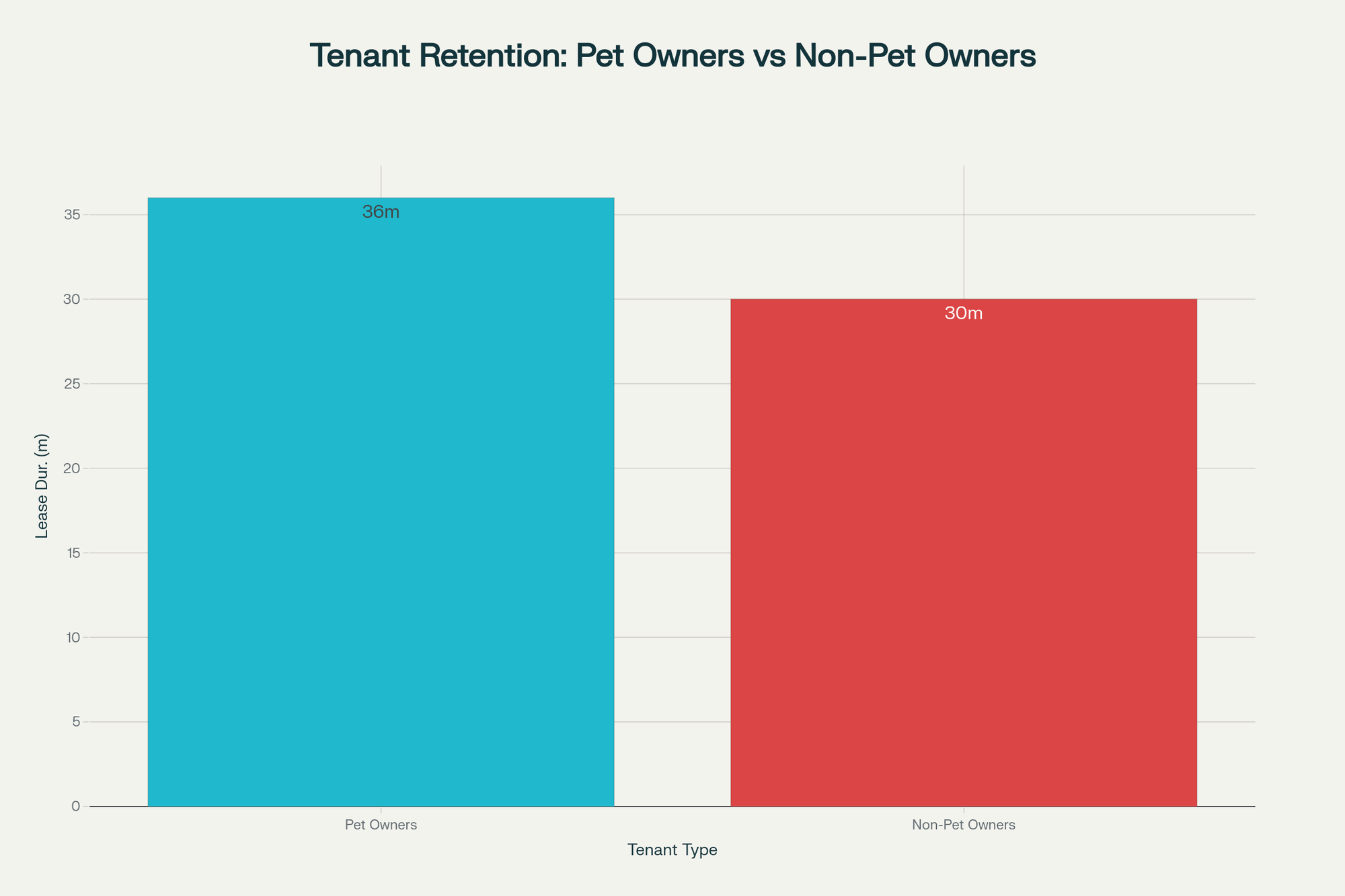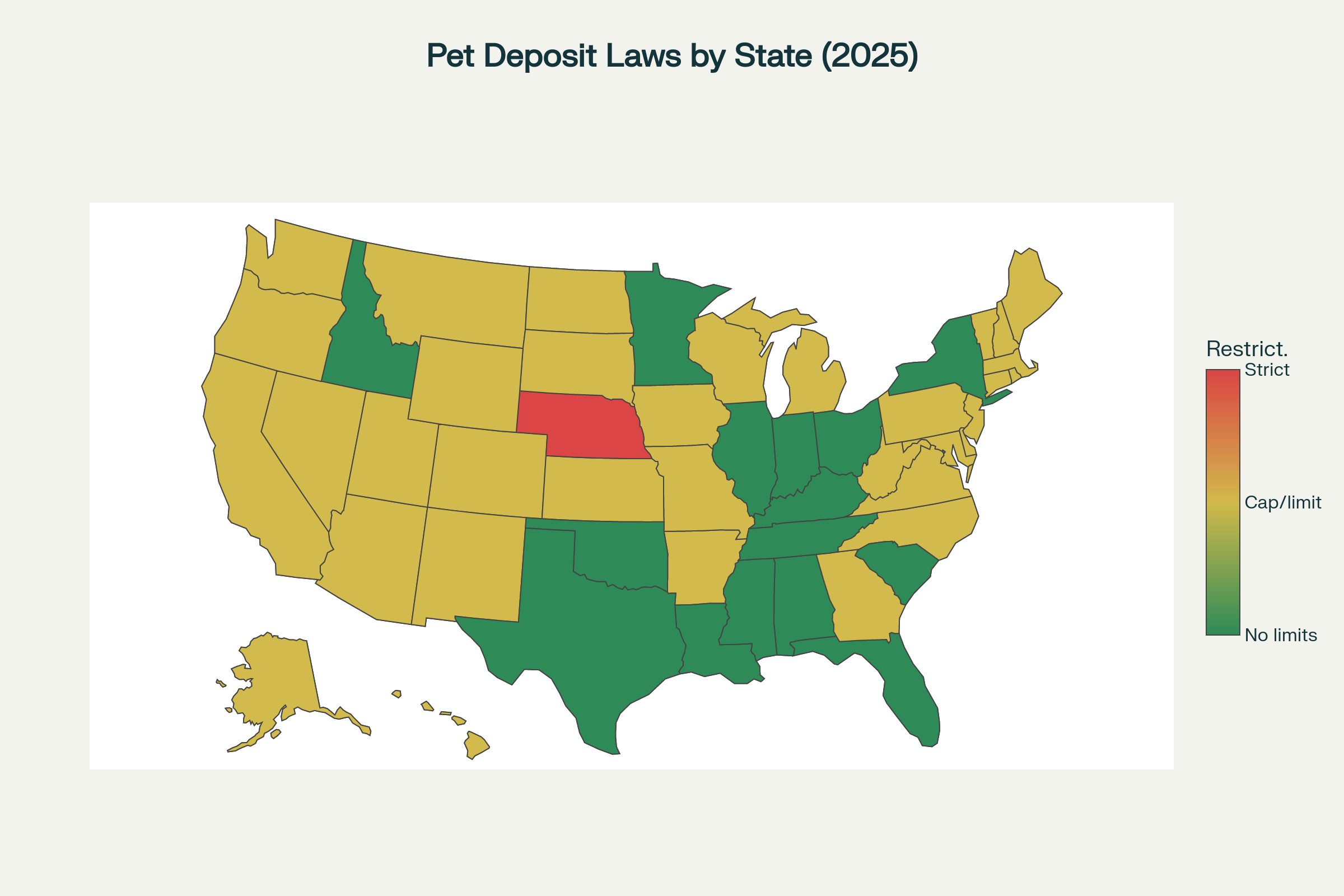Pet Deposits: The Ultimate Guide for Property Managers & Tenants
Confused about pet deposits, pet rent, or service animal rules? Learn everything landlords need to know—legal limits, refund rules, best practices, and templates for pet addendums.

When I first allowed pets in my rentals, I had no idea how quickly fur could turn into frustration.
It started with a friendly golden retriever — sweet temperament, happy tail, loving owner. But by the end of that lease, my hardwood floors looked like they’d been sanded with paws, and the walls carried a scent no amount of Febreze could touch. That’s when I learned the hard way: having a clear pet deposit policy is all about setting expectations, damage control, and protecting your investment.
It's also about following the law, because, believe it or not, the law is pretty detailed when it comes to allowing animals in rental properties. And even a first time offense can cost landlords upwards of $75,000 in fines. Yikes!
If you’re a landlord or property manager considering allowing pets — or already managing a few furry tenants — this guide is for you.
We’ll break down everything you need to know about pet deposits, pet fees, and pet rent:
- What they are (and aren’t)
- What the law allows
- How much to charge
- When and how to refund
- And what to do about service animals, ESA's, and Fair Housing compliance
Whether you own a duplex or manage a high-rise, a strong pet policy backed by smart deposit practices can make your rentals more competitive and your job less stressful. Plus, with nearly 70% of U.S. households owning pets, offering pet-friendly units could open the door to longer tenancies and happier tenants.
Let’s dig into the details and make your property pet-prepared and profit-protected.
What Is a Pet Deposit?
When you welcome pets into a rental property, you’re also welcoming their quirks — muddy paws, scratched doors, occasional accidents, and all.
A pet deposit creates a financial buffer to cover the extra wear and tear pets can leave behind. It gives you a way to manage risk without turning away pet owners — and in today’s market, that’s often a smart business move since pet owners tend to stay at their rentals 6-8 months longer, on average, then their non-pet-owning counterpart.
Not to mention, pet owners now make up the largest demographic bloc of renters.

A pet deposit is a refundable sum of money collected at the beginning of a lease agreement to cover any damage caused specifically by a tenant’s pet. Think of it as a sibling to the standard security deposit, but tailored to cover scratched flooring, stained carpets, or chewed blinds (ugh, .
Under federal regulations like 24 CFR § 5.318, a pet deposit is defined as a refundable financial safeguard for expenses directly caused by pets — excluding damage considered normal wear and tear.
In private rental housing, many states allow landlords to collect pet deposits, though rules vary dramatically by state and even by city.
Pet Deposit vs. Pet Fee vs. Pet Rent
It’s easy to confuse these three, especially when they’re all charged upfront or appear together on a lease. But legally and practically, they serve different purposes.
| Term | Refundable? | Purpose | Typical Amount | How It’s Used |
|---|---|---|---|---|
| Pet Deposit | ✅ Yes | Pet-related damage coverage | $200–$600 (avg.) | Refunded if no damage at move-out |
| Pet Fee | ❌ No | One-time cost for allowing pets | $100–$500 | Not tied to damage; covers general wear |
| Pet Rent | ❌ No | Monthly premium per pet | $10–$50/month | Ongoing income to offset maintenance |
While pet fees and pet rent are non-refundable and often treated as part of rental income, a pet deposit must be held separately, documented properly, and refunded unless actual damage is identified and itemized.
💡 Pro Tip: In some states, pet deposits count toward the maximum allowable security deposit. Always check your local laws before stacking fees.
Why Pet Deposits Are Important
Having a clearly defined pet deposit policy builds transparency with tenants, reduces disputes at move-out, and provides a financial cushion for unexpected repairs. It also gives you the flexibility to offer pet-friendly rentals without absorbing the full risk yourself.
Up next, we’ll explore how much to charge for a pet deposit — including average rates, risk-based pricing strategies, and signs that a tenant’s pet may warrant a closer look.
How Much Should You Charge for a Pet Deposit?
There’s no one-size-fits-all number — but you don’t need to guess either. Pet deposits typically fall in the $200–$600 range per pet, depending on the type of pet, property type, and the lease terms.
Let’s break it down with a few real-world factors worth considering:
1) Location + Market Standards
Start by checking what other landlords in your area are charging. If your competitors are collecting $300 per pet, going too far above or below that number might raise eyebrows or drive applicants elsewhere.
2) Pet Type, Size & Breed
A 15-pound cat usually poses less risk than a 90-pound German Shepherd. Adjust your deposit based on potential wear and tear — especially in furnished units or homes with carpet, hardwood floors, or shared outdoor areas.
3) Lease Duration
For short-term leases (under 6 months), you may want a higher deposit or even a non-refundable pet fee instead. Long-term leases tend to balance out the risk over time.
4) Real-World Data Point
According to industry data, the average cost of pet-related damage during a tenancy is around $210. This includes scratched flooring, stained carpets, and damage to doors or screens.
Charging a deposit between $200 and $600 per pet typically covers the average risk — and helps you avoid paying out of pocket at move-out.
Pet Deposit Laws: What Landlords Need to Know
Before collecting a pet deposit, you'll want to make sure you understand how federal, state, and local laws affect what you can charge, how you handle the money, and when you must return it.
In some places, you have plenty of flexibility. In others, pet deposits fall under strict security deposit rules — or may even be prohibited entirely.
Federal Law & Service Animal Exceptions
Under the Fair Housing Act, landlords cannot charge a pet deposit, fee, or pet rent for service animals or emotional support animals (ESAs). These animals are considered necessary accommodations — not pets — and must be exempt from pet-related charges, regardless of your policies.
This includes both certified service animals and verified emotional support animals with proper documentation. Charging a fee or deposit for these animals can expose landlords to discrimination claims and serious penalties.
🛑 Important: You may ask for documentation supporting an ESA request, but you cannot deny housing or impose pet-related charges simply because the animal doesn’t “look” like a service animal.
State-by-State Pet Deposit Laws

States vary widely in how they regulate pet deposits. Some restrict the total amount a landlord can collect as a deposit, including pet-related charges. Others impose specific caps or requirements for how funds must be held or refunded.
Here’s a quick snapshot of how a few key states handle pet deposits:
| State | Pet Deposit Rules |
|---|---|
| California | Pet deposit counts toward 2-month maximum total deposit; no separate cap |
| New York | Security deposit may not exceed 1 month’s rent; no separate pet deposit allowed |
| Texas | No state limit on pet deposits; landlords may charge separately from security deposit |
| Colorado | Pet deposit capped at $300; must be separate from security deposit |
| Washington (Seattle) | Pet deposit limited to 25% of one month’s rent; only one pet deposit per household allowed |
Local laws may add additional rules, so be sure to check with your city or county housing department for the most up-to-date information. When in doubt, consult with a local attorney or property management expert.
Holding and Returning Pet Deposits
Most states require that pet deposits be held in a separate escrow account and returned within a certain timeframe after move-out — usually between 14 and 30 days. Landlords must provide an itemized list of deductions if any portion of the deposit is retained for cleaning or repairs.
Documentation is non-negotiable. Conduct thorough move-in and move-out inspections, take photos of any pet-related damage, and keep repair receipts. This will help you CYA by helping prevent disputes or legal action.
In the next section, we’ll look at how landlords actually apply these laws and pet policies in real-world settings — including how small landlords and large property management firms handle pet deposits differently.
How Pet Deposits Work in the Real World
Policies and legal limits are one thing, but how do pet deposits actually get handled on the ground? Let’s take a look at how landlords and property managers apply these rules in everyday leasing scenarios.
Small-Scale vs. Large-Scale Management
Small landlords — like those managing a single rental home or a couple of units — tend to keep things simple. Many charge a flat-rate pet deposit, often folded into the main security deposit to avoid extra bookkeeping. A common approach might be $250–$500 per pet, written into the lease with a brief pet clause.
Large property management companies take a more structured approach. They may use tiered deposit systems based on the pet’s size, breed, or risk category. Some even integrate third-party screening services like PetScreening or OurPetPolicy to manage pet applications, vaccination records, and policy compliance at scale.
🔧 Tip: Even if you're a solo landlord, adopting digital tools for pet screening and lease customization can help prevent headaches down the road. Learn more about our recommended property management software solutions.
Common Lease Scenarios Involving Pet Deposits
Pet deposits come into play in several recurring leasing situations:
- Move-in: The pet deposit is collected alongside the security deposit and first month’s rent. Tenants sign a pet addendum outlining responsibilities and conditions.
- Mid-lease pet additions: If a tenant adopts a pet after signing the lease, you can amend the agreement and collect a pet deposit at that point — provided your policy allows it.
- Lease renewals: You may adjust the pet deposit amount based on new conditions or property wear, but changes must be clearly documented and agreed upon by both parties.
- Move-out inspections: Pet-related damage is assessed, itemized, and deducted from the deposit as needed. Any remaining balance is refunded within the required legal timeframe.
Pet Deposit Management Workflow
- Pet Application: Collect pet details including breed, age, size, and vaccination status.
- Deposit Collection: Ensure funds are held in a compliant escrow or trust account, separate from operating funds if required by law.
- Routine Inspections: Conduct periodic property checks and document any pet-related wear or violations.
- Damage Assessment: At move-out, compare the unit’s condition to your move-in documentation to determine if deductions are warranted.
- Refund Distribution: Return remaining funds with an itemized statement of any deductions — ideally within 14–30 days, depending on your state.
Each step help keep your pet policy straightforward and enforceable, both to you and your tenant.
In the next section, we’ll look at the most common challenges landlords face when managing pet deposits — and how to avoid costly mistakes.
Common Challenges in Managing Pet Deposits
Even with a solid pet policy and the best intentions, things can still go sideways. Pet deposits are often misunderstood by both tenants and landlords — and that misunderstanding can lead to lost money, legal risk, or unnecessary tenant turnover.
Misunderstanding Pet Fees vs. Pet Deposits
This is the number one issue. Tenants sometimes assume their pet deposit is non-refundable, while landlords mistakenly treat pet fees like a pet deposit. It’s critical to make the distinction clear in your lease:
- Pet deposit: Must be refundable. Held to cover specific damage caused by pets.
- Pet fee: Non-refundable. A one-time cost for allowing a pet in the unit.
- Pet rent: Monthly charge, unrelated to damage or deposits.
If you charge a “pet deposit” but treat it like a fee, that could land you in legal hot water — especially in states with strict security deposit laws.
Improperly Charging for Service Animals
One of the biggest compliance pitfalls: charging a pet deposit or pet rent for a service animal or emotional support animal (ESA). Under the Fair Housing Act, these animals are not considered pets, and tenants cannot be charged pet-related fees or deposits for having them.
If you're unsure whether an animal qualifies, it’s okay to request documentation. But charging the wrong fee — even unintentionally — can result in civil penalties of up to $75,000 for a first offense, with potential additional costs if the landlord faces lawsuits for discrimination or damages.
🚩 Red Flag: If your lease or policy uses the word “pet” in every section, double-check that you’re not accidentally including service animals in your deposit or fee language.
Weak Documentation = Lost Disputes
Another common challenge is lack of documentation when damage occurs. Without a detailed move-in inspection report, time-stamped photos, or itemized repair invoices, it’s difficult to justify deductions from the pet deposit — and courts often side with tenants.
To protect yourself:
- Use a detailed move-in checklist (digital or paper)
- Photograph floors, doors, baseboards, and yard areas
- Keep maintenance records and receipts
- Communicate pet expectations clearly in writing
Charging Too Much — Or Too Little
Overcharging can scare away quality tenants. Undercharging can leave you eating repair costs. Some landlords fail to update pet deposit policies as property conditions change — or forget to assess higher-risk situations like large dogs or multiple pets.
The key is balance. Your pet deposit should reflect real risk — not arbitrary numbers.
Measurable Impacts of Mismanagement
- Legal costs: Non-compliance with Fair Housing rules or state laws can result in major penalties
- Lost rent: Poor pet policies can drive away long-term tenants and increase turnover
- Reputation damage: Disputes over pet deposits often show up in online reviews
More About Pets in Rentals
Pet deposits are just one part of the risk management puzzle. When you allow pets in your rental units, other considerations come into play — from insurance coverage, to lease structure, to hidden pets. Here are a few related topics that can help you build a more secure, well-rounded rental strategy.
Unauthorized Pets in the Rental
One of the trickiest challenges landlords encounter is discovering an unauthorized pet in the unit. Sometimes this happens because a tenant assumes “one more cat won’t matter,” or they intentionally try to hide the animal to avoid deposits and fees. Either way, it can cause headaches for both sides.
Here’s how to handle it effectively:
- Review the lease first: Make sure your lease includes clear language about pet policies, deposits, and consequences for violations.
- Document the discovery: Take photos (if possible, without violating tenant privacy or other related laws), write notes, and keep a record of communication with the tenant. This protects you if the issue escalates.
- Send written notice: A polite but firm reminder of the lease terms is often enough to prompt compliance. Outline the next steps in writing (e.g., pay deposit, remove pet, face penalties, or even an eviction filing) via a lease violation.
- Give options: In some cases, offering the tenant the chance to legitimize the pet with a deposit and addendum is a win-win. For repeat or intentional violations, stricter enforcement may be necessary.
- Stay compliant: If the tenant claims the animal is a service animal or emotional support animal, pause enforcement and follow Fair Housing guidelines to avoid legal risk.
A Real-World Example
One landlord I know rented out a one-bedroom apartment to a single tenant with no pets listed on the lease. A few months in, during a mid-lease inspection, they discovered a large pit bull quietly living there. The tenant admitted they didn’t disclose the dog because they were worried about “being denied,” but by that point, the damage was already showing in the scratched doors and torn carpet.
Instead of jumping straight to eviction, the landlord documented everything, sent a written notice, and gave the tenant two clear options: pay the deposit and sign a pet addendum, or remove the dog within 10 days. The tenant chose to stay and legitimize the pet, which not only covered the landlord financially but also set a precedent for clear communication going forward.
Pet Insurance: Who Pays and What It Covers
Property managers rarely make it a requirement (though, perhaps it would be wise to do so), but some pet-owning tenants voluntarily carry pet liability insurance — usually bundled into a renters insurance policy. These plans can cover injuries or property damage caused by the pet (e.g., a dog bite or scratched-up floors in a neighboring unit).
Some landlords make pet insurance a lease requirement for higher-risk animals or restricted breeds. It’s one more layer of protection — and it can reduce your own liability exposure if something goes wrong.
Renters Insurance: Integration with Pet Clauses
Standard renters insurance doesn’t always cover pet-related damage to your unit, but it can protect your tenant in other scenarios, like if their dog injures a guest. You can strengthen your lease by requiring renters insurance and adding a clause that confirms:
- The tenant is responsible for any pet-related damages or liability claims
- The pet is not excluded from their renters insurance policy
- Proof of coverage must be provided annually or upon renewal
Co-Signers or Guarantors for Risky Pet Owners
If you’re hesitant about a pet-owning applicant — maybe due to poor credit, a large breed, or a prior incident — you can require a co-signer or guarantor as part of the lease. This person agrees to take on financial responsibility if the tenant fails to cover rent or damages.
This is especially useful in college towns, multi-pet households, or situations where the tenant doesn’t meet your normal qualifications. Just make sure the guarantor signs a separate, binding agreement outlining their responsibilities.
These complementary tools — insurance, renters clauses, and guarantors — work best when paired with a strong pet deposit policy. Together, they create a more predictable, more professional rental experience for everyone involved.

Frequently Asked Questions
Do you get your pet deposit back at the end of the lease?
Yes, pet deposits are refundable if there is no pet-related damage beyond normal wear and tear. After the tenant moves out, the landlord must inspect the unit, itemize any deductions, and return the remaining deposit within the timeline required by state law — usually within 14 to 30 days.
Can landlords charge a pet deposit for a service animal?
No, under the Fair Housing Act, landlords cannot charge a pet deposit, pet rent, or pet fee for a service animal or verified emotional support animal. These animals are considered necessary accommodations — not pets.
How much should a pet deposit be?
Most pet deposits range between $200 and $600 per pet, depending on the pet’s size, type, and the property’s features. Some landlords use a tiered system or charge a flat amount per household. Always check state laws, as some locations cap the total deposit amount allowed.
Can landlords charge both a pet fee and pet deposit?
Yes, in most states, landlords can charge both a refundable pet deposit and a non-refundable pet fee — as long as total charges stay within legal limits. Be sure to clearly explain the difference in your lease to avoid tenant confusion.
What happens if a tenant doesn’t pay pet rent?
Unpaid pet rent is treated like unpaid regular rent. Landlords can issue a notice of non-payment, apply late fees (if allowed by the lease), and initiate eviction proceedings if necessary. It’s important to document all communications and follow your lease enforcement process consistently.
Are pet deposits refundable?
Yes, pet deposits are designed to be refundable. If the unit is free of pet damage at move-out, the full deposit should be returned. If there’s damage, landlords must provide an itemized deduction report and return any unused portion.
Final Takeaways + Landlord Tips
Allowing pets in your rentals means stepping into a new level of responsibility — one that calls for preparation, rules, and the right systems in place. It’s not a risk-free decision, but with a strong policy behind you, it can become one of the smartest ways to attract reliable, long-term tenants, and an improved bottom line.
Here’s what to keep in mind as you build or revise your approach:
- Be consistent: Apply your pet policy evenly across all tenants and properties to avoid confusion and/or legal risk.
- Be clear: Spell out the difference between pet deposits, fees, and rent in your lease. Tenants should know exactly what they’re paying — and why.
- Be compliant: Know your local laws, and never charge for service animals or emotional support animals. When in doubt, check HUD guidance or consult a local expert.
- CYA, CYA, CYA: Keep a paper trail of pet applications, inspection photos, receipts, lease addenda, and communications. If you ever face a dispute or legal challenge, solid documentation is your best protection.
Pet deposits don’t need to be a headache, especially when you’ve got a system in place. From screening and inspections to software and deductions or refunds, the key is to put your process in writing and stick to it.
If you’re ready to update your lease or create a pet-friendly policy from scratch, we’ve put together a downloadable template to help:
Thanks for reading! Whether you’re managing one rental or fifty, a clear pet deposit policy is one of the smartest tools you can put in your leasing toolkit.
Disclaimer
This article is for informational purposes only and is not intended as legal, financial, or professional advice. Landlord-tenant laws vary by state and municipality. Always check your local regulations and consult with a qualified attorney or property management professional before making decisions about pet deposits, fees, or rental policies.






